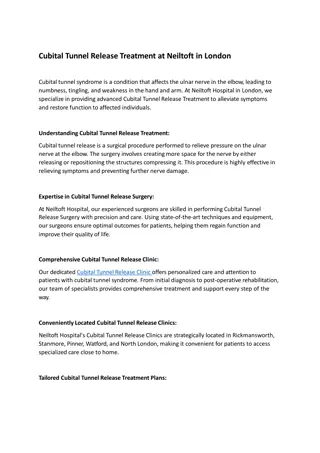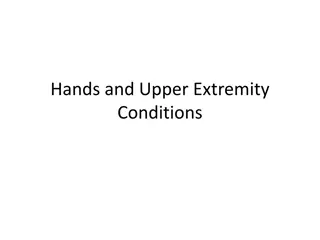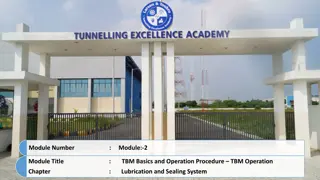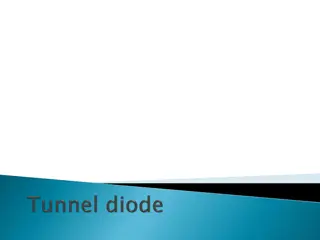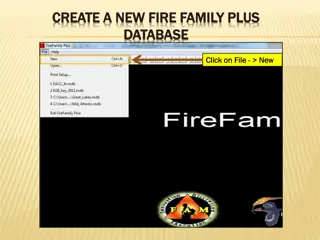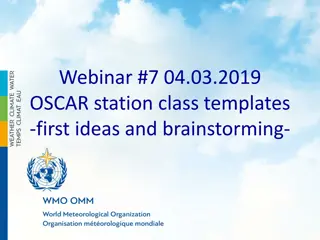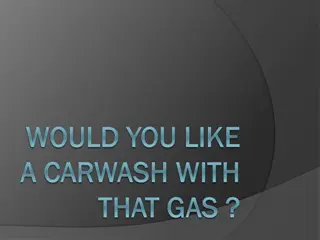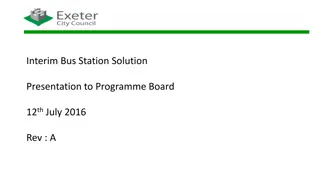History of Field Station Kunia and Kunia Tunnel Timeline
Explore the intriguing history of Field Station Kunia and Kunia Tunnel, from their establishment during World War II to their evolution into classified facilities. Learn about the environmental cleanup activities and significant developments that have shaped these sites over the decades.
Uploaded on Sep 11, 2024 | 0 Views
Download Presentation

Please find below an Image/Link to download the presentation.
The content on the website is provided AS IS for your information and personal use only. It may not be sold, licensed, or shared on other websites without obtaining consent from the author. Download presentation by click this link. If you encounter any issues during the download, it is possible that the publisher has removed the file from their server.
E N D
Presentation Transcript
Field Station Field Station Kunia TCE Exposure TCE Exposure Kunia Tunnel Tunnel
History of Field station Kunia Tunnel -Tunnel Creation Date 1941 Dec 1942 Jan 1944 Nov 1945 Sep 1945 Sep 1953 Jun 1964 May 1966 Jun 1976 Jan 1980 Jan Timeline of Field Station Kunia investigation analysis and environmental cleanup activity Japanese attack pearl Harbor Construction Begins to build a bomb proof underground airplane manufacturing facility Constuction completed World War 2 ends Tunnel converted to storage for ammunition and torpedos by the navy Navy converts to a "secret facility" Preliminary Assessment/Site Investigation Report, Kunia Field Station Facility is hardened for NBC attacks Facility turned over to GSA Army assumes control of Kunia
History of Field station Kunia Tunnel KRSOC created 1980 Nov 1993 Jan 1994 Nov 1995 Jan 1995 May Naval Security Group Activity Kunia was officially commissioned November 14, 1980, at Wheeler Air Force Base Renamed Kunia Regional Sigint operations facility (KRSOC) Report to the Chairman, Committee on Governmental Affairs, U.S. Senate Subsurface Investigation and Removal of Kunia 1 Underground Fuel StorageTank, Field Station Kunia Site Investigation Report, Microwave Tower and Building 25, Kunia Field Station, Oahu, Hawaii Site Characterizations, Remedial Designs, and Soil Remediation of Petroleum-Contaminated Soil at Five U.S. Army Installations on Oahu, Hawaii, Final Engineering Evaluation Report, Volume I of III Environmental Compliance Inventory and Document Data Survey for Polychlorinated Biphenyls (PCB) at Various Locations, FY93 OMA Package A-22 and Survey and Labeling of Electrical Devices at Various Locations, Hawaii, Final Survey Report Naval Security Group Activity assumes control 1995 Jun 1995 Oct 1995 Oct
History of Field station Kunia Tunnel Environmental Cleanup Part 1 Site Characterizations, Remedial Designs, and Soil Remediation of Petroleum-Contaminated Soil at Five U.S. Army Installations on Oahu, Hawaii, Final Closure Report Final Inspection Report Asbestos Inventory Naval Security Group - Kunia Hawaii Final Underground Storage Tank Management Plan for Naval Security Group Activity Kunia, Oahu, Hawaii Cultural Resources Study, Naval Security Group Activity, Kunia, Oahu, Hawaii. Asbestos, Final Operations and Maintenance Program for Commander, Pacific Division, Naval Facilities Engineering Command, Pearl Harbor, Hawaii, Naval Security Group Activity, Kunia, Hawaii Site Investigation Report, UST No. DF1, Power Plant Room Clean Fuel Tank, NAVSECGRUACT, Kunia, Hawaii Radon Assessment Report for U.S. Naval Security Group Activity, Kunia April 1999 Kunia Security Group Activity (KSGA), Antenna Tower Lead Investigation June 1999 Kunia Security Group Activity (KSGA), Antenna Tower Lead Investigation Secured Area July 1999 Environmental Compliance Evaluation - Naval Security Group Activity July 20-26, 1999 Draft Remediation Verification Report, Removal of Lead-Contaminated Soil, Former Microwave Tower, Kunia, Oahu, Hawaii December 1999 Closure Report, Removal of Underground Storage Tanks, Naval Security Group Activity, Kunia, Hawaii January 2000 Kunia Lead and Asbestos Study, NAVSECGRUACT Kunia, Department of the Navy, Building 9, Kunia, Oahu, Hawaii February 2000 Kunia Lead and Asbestos Study, NAVSECGRUACT Kunia, Department of the Navy, Building 9, Kunia, Oahu, Hawaii February 2000 An Investigation of Indoor Air Quality at NSG-Kunia Regional SIGINT Operations Center February 2000 Final Environmental Baseline Survey, Kunia Field Station, Wahiawa, Oahu, Hawaii September 2000 1996 Jul 1997 Nov 1998 Mar 1998 Jul 1999 Mar 1999 Mar 1999 Apr 1999 Jun 1999 Jul 1999 Jul 1999 Dec 2000 Jan 2000 Feb 2000 Feb 2000 Feb 2000 Sep
History of Field station Kunia Tunnel Environmental Cleanup Part 2 2000 Oct 2004 Sep 2004 Dec 2005 Sep 2005 Oct 2005 Dec 2006 Dec 2006 Jan Final Human Health and Ecological Risk Assessment, Kunia Field Station, Kunia October 2000 U.S. Naval Security Group Activity (NSGA) Kunia and the U.S. Naval Security Group Activity (NSGA) Pearl Harbor merged commands NIOC Hawaii ASBESTOS Sample Analysis 1992-2004 NSGA Hawaii was administratively closed Navy Information Operations Command (NIOC) Hawaii, Schofield Barracks, HI established NIOC Hawaii LEAD Sample Analysis 1990-2005 Industrial Hygiene Bulk-Wipe Sampling Log Results Operation and Maintenance Plan - Remedial Cap - Kunia Field Station January 2006 the National Security Agency, Central Security Service (NSACSS) located in Kunia, Hawaii, held a groundbreaking ceremony for the new Hawaii Regional Security Operations Center (HRSOC) at the Naval Computer and Telecommunications Area Master Station Pacific (NCTAMS PAC), located in Wahiawa, Hawaii Final Environmental Condition of Property NAVY INFORMATION OPERATION CENTER (NIOC) HAWAII Kunia, Oahu, Hawaii Facility replaced by the Hawaii Cryptologic Center Ongoing LUST remediation Army Defense Environmental Restoration Program FY2013 2007 Aug 2012 Apr 2012 Apr 2013 Oct
Exposure to contaminants During their duty assignment, personnel were exposed to the following hazardous materials at Field Station Kunia Lead Paint Asbestos Polychlorinated Biphenyls (PCBs) Pesticides, fumigant, and herbicides in the wells (EPA Superfund Site): DBCP, Heptachlor, Telone II, Vydate, Nemacur III Aldrin, made by DOW and Shell. TCE Field Station Kunia Schofield Barracks Wheeler AFB/Army Airfield
Lead Lead-Based Paint Survey Sixteen samples were collected from the piping, walls, poles, cabinets, ceilings and railings of eight buildings at the project site and analyzed for lead-based paint content. Three of the six samples taken from the Digestion Control Building, the Effluent Pump Station and Force Main, and the Laboratory Building were found to contain lead above the Department of Housing and Urban Development (HUD) guideline of 0.5 percent (5000 parts per million) of lead by weight. Lead was also detected, although at levels below the HUD guideline, in all of the remaining nine samples taken from the Receiving Facility, the Control Building, the Waste Activated Sludge (WAS) Building and the nearby WAS Pump Station, and the Centrifuge Building. All LBP material should be disposed of by HAZWOPER trained workers prior to demolition.
Asbestos In 1991 a study was conducted that found asbestos present in floor tile and mastic in the tunnel before the airshaft. The exhaust piping also confirmed the presence of asbestos. Asbestos has been known to cause renal (kidney) cancer and mesothelioma (lung cancer).
Polychlorinated Biphenyls (PCBs) Polychlorinated biphenyls (PCBs) are a group of manufactured organic chemicals that contain 209 individual chlorinated chemicals (known as congeners). Concentrated PCBs are either oily liquids or solids and are colorless to light yellow in color. They have no known smell or taste. There are no known natural sources of PCBs. Some commercial PCB mixtures are known in the United States by their industrial trade name, Aroclor. PCBs don't burn easily and are good insulating material. They have been used widely as coolants and lubricants in transformers, capacitors, and other electrical equipment. The manufacture of PCBs stopped in the United States in 1977 because of evidence that they build up in the environment and cause harmful health effects. Products containing PCBs are old fluorescent lighting fixtures, electrical appliances containing PCB capacitors, old microscope oil, and hydraulic fluids. During the time that PCBs were manufactured, there were often no effective controls on disposal. Because they do not break down easily, PCBs are now found widely distributed in our environment. Generally their concentrations in the environment are quite low. However, the chemical properties of PCBs cause them to be concentrated up the food chain.
Pesticides At one time, it was thought that contamination of Hawaii's groundwater was highly unlikely. The great depth to the water tables and the filtering action of the percolation process provided a sense of insurance against chemical contamination. However, between 1980 and 1983, EDB, DBCP, TCP and atrazine were found in various central Oahu wells. Hawaii's aquifers, on which we depend so heavily, were indeed vulnerable to pollution. And because they are so deep and large, once contaminated they are difficult to clean up. Since water treatment is expensive and since no treatment can remove 100% of a contaminant, prevention is the key to keeping Hawaii's drinking water safe. Pesticide applicators can contribute toward this goal by learning more about Hawaii's groundwater and avoiding both direct and indirect contamination.
TCE was present at least as recent as 1994 "Report to the Chairman, Committee on Governmental Affairs, U.S. Senate" "Although installation officials believe they have identified all of the sites, it is possible additional sites could be found. To determine whether the contamination is spreading off the installation, Schofield had a contractor test private drinking water wells near the installation for contamination. Results from these tests did not show any TCE contamination at private wells. However, some of the wells on Field Station Kunia, a small Army installation adjoining Schofield, have shown low levels of TCE contamination. This document clearly states that the Field Station Kunia Wells contained TCE as late as Nov 1994 (Publication Date) GAOREPORTS-NSIAD-95-8.PDF We were physical witnesses of continued cleanup. The budget does show continuing cleanup post 1984 in this document. DERA funding Fiscal year - Requested/planned - Received 1984 $50,000 $50,000 1991 985,380 1,005,400 1992 5,356,220 956,220 1993 8,300,000 12,330,000 Plus - future requested money
Still ongoing remediation contamination of the site In 2013 they were still resolving contaminated soil issues (LUST Remediation): https://www.aec.army.mil/Portals/3/IAP/HI-Kunia.pdf
What is TCE? Trichloroethylene Trichloroethylene is a nonflammable liquid chlorinated hydrocarbon used as an industrial solvent. It is often referred to as TCE, Trike, or tri and is sold under numerous brand names. Recommended daily intake: None Absorption: intestine, inhalation, skin Toxicity/symptoms: Nervous system, Cancer General facts: Long history of use as a solvent. Common occupational hazard in certain industries. Toxicity to humans and wildlife is well documented. Environmental: Found in indoor and outdoor air, drinking and surface water. An important chemical found in US EPA Superfund sites.
How can you be exposed to TCE Air Trichloroethylene in air can easily enter your body when you breathe. Most of the trichloroethylene that you breathe in will go into your bloodstream and into other organs. A small amount of trichloroethylene in the air can also move through your skin and into your bloodstream. Water When trichloroethylene is found in water, it can enter your body when you drink or touch the water or when you breathe in steam from the water. Most of the trichloroethylene that you breathe in or drink will move from your stomach or lungs into your bloodstream. When you touch water containing trichloroethylene (such as showering or bathing with trichloroethylene-contaminated water), some of it can get through your skin into your body. Also, you can be exposed when trichloroethylene in groundwater evaporates and migrates into air spaces beneath buildings to enter the indoor air, a process termed vapor intrusion, and you breathe that contaminated indoor air. Soil You can be exposed to trichloroethylene in soil when small amounts of soil are transferred to your mouth accidentally, when your skin touches the soil, or when you breathe air or dust coming from the soil. You can also be exposed when trichloroethylene in soil evaporates and migrates into air spaces beneath buildings to enter the indoor air, a process termed vapor intrusion, and you breathe that contaminated indoor air. Food Trichloroethylene has been detected in table-ready foods at concentrations generally in the range of 2 100 ppb.
How were Field Station Kunia Tunnel workers Exposed to TCE Contaminated Soil/Dust Formations in contaminated fields Fire escapes into pineapple fields Water supply Ventilation system using contaminated well water Limited ventilation in tunnel causing concentrated exposure Environmental seepage (water through walls) Pineapple provided from the fields above
Poor ventilation and other conditions 1988 Improvements to Field sites : GOVPUB-C13- db9608c73d860a22903ee457b23d4947.pdf https://www.gpo.gov/fdsys/pkg/GAOREPORTS-NSIAD-95-8/pdf/GAOREPORTS-NSIAD-95- 8.pdf Another area for improvement is the functioning of the heating, ventilating, and air conditioning systems (HVAC) . Recommendations include development and implementation of a regular maintenance program (that is followed faithfully) for all facilities, continued implementation of the upgrades for Berlin with installation of insulation for the analytic areas to increase temperatures, and balancing the systems so that there are not excessively cold and hot areas in the same space. At Kunia, implement the planned upgrades to the entire HVAC system. If that, combined with regular maintenance does not solve the problems of mold, dust, and other contaminants, then do a survey of the indoor air quality with particular attention to biological contaminants. Originally scheduled for 1986, the renovation of the Air Filtration system began in 1990.
Water as a source Well 2804-04 was still in use during a 1994 investigation. Seven groundwater wells (Well numbers 2803-01 through 2803-07) are located at Kunia. Most of these wells were installed during the late 1950s by the U.S. Navy. Del Monte Corporation installed wells 2803-05 and 2803-07 for agricultural purposes in 1959 and 1979, respectively. Potable water is currently supplied to Kunia by the Schofield Barracks water system because the wells are reportedly contaminated with solvents and agricultural fumigants (Larry Heiser). Well 2804-04 was observed at the intersection of the main facility road near Building 30 during a 1994 investigation. This well supplies water to the cooling tower, and is reportedly contaminated with trichlorethylene (TCE). The source of TCE is unknown. According to the State Department of Health, well 2703-01 was closed down in 1980 because of the presence of dibromo-chloropropane (DBCP), an agricultural fumigant. Wells 2901-03, -04, and -07 are located at Schofield Barracks and actively serve Wheeler Army Airfield, Schofield Barracks, and Kunia. The water from these wells is treated through air stripping towers at Schofield Barracks to remove TCE contamination before distribution. (USACE NIOC report April 2012/NIOC HI ECP.PDF)
What are short term symptoms of exposure to TCE Short-term exposure effects Trichloroethylene was once used as an anesthetic for surgery. People who are overexposed to moderate amounts of trichloroethylene may experience headaches, dizziness, and sleepiness; large amounts of trichloroethylene may cause coma and even death. Some people who breathe high levels of trichloroethylene may develop damage to some of the nerves in the face. Other effects seen in people exposed to high levels of trichloroethylene include evidence of nervous system effects related to hearing, seeing, and balance, changes in the rhythm of the heartbeat, liver damage, and evidence of kidney damage. Some people who get concentrated solutions of trichloroethylene on their skin develop rashes. Relatively short-term exposure of animals to trichloroethylene resulted in harmful effects on the nervous system, liver, respiratory system, kidneys, blood, immune system, heart, and body weight. Scleroderma
What are long term symptoms of exposure to TCE Exposure to trichloroethylene in the workplace may cause scleroderma (a systemic autoimmune disease) in some people. Some men occupationally- exposed to trichloroethylene and other chemicals showed decreases in sex drive, sperm quality, and reproductive hormone levels. Long-term exposure studies in animals have mainly focused on carcinogenicity and relatively insensitive noncancer end points following oral exposure; these studies are not helpful in defining noncancer end points in humans following long-term exposure. However, depressed body weight and evidence of effects on the thymus were reported in one recent study of mice exposed to trichloroethylene via their mothers during gestation and lactation and via the drinking water for up to 12 months thereafter.
TCE and Cancer There is strong evidence that trichloroethylene can cause kidney cancer in people and some evidence that it causes liver cancer and malignant lymphoma (a blood cancer). Lifetime exposure to trichloroethylene resulted in increased liver cancer in mice and increased kidney cancer in rats at relatively high exposure levels. There is some evidence for trichloroethylene-induced testicular cancer and leukemia in rats and lymphomas and lung tumors in mice.
How many people worked at the tunnel? The annual population of the Kunia tunnel (estimated from 1988 report): Operators:154 Analysts: 77 Administrators: 42 Total: 273
Are Field Station Kunia tunnel workers showing any symptoms? Yes. Over 80%
What kind of Symptoms are they having? Lung issues Cancer Muscular Cramping Nerve Pain Numbness
What is Scleroderma Scleroderma is an autoimmune disease that can be caused by TCE exposure Systemic scleroderma (systemic sclerosis) The changes occurring in systemic scleroderma may affect the connective tissue in many parts of the body. Systemic scleroderma can involve the skin, esophagus, gastrointestinal tract (stomach and bowels), lungs, kidneys, heart and other internal organs. It can also affect blood vessels, muscles and joints. The tissues of involved organs become hard and fibrous, causing them to function less efficiently. The term systemic sclerosis indicates that sclerosis (hardening) may occur in the internal systems of the body. There are two major recognized patterns that the illness can take - diffuse or limited disease. In diffuse scleroderma, skin thickening occurs more rapidly and involves more skin areas than in limited disease. In addition, people with diffuse scleroderma have a higher risk of developing sclerosis or fibrous hardening of the internal organs. About 50 percent of patients have a slower and more benign illness called limited scleroderma. In limited scleroderma, skin thickening is less widespread, typically confined to the fingers, hands and face, and develops slowly over years. Although internal problems occur, they are less frequent and tend to be less severe than in diffuse scleroderma, and are usually delayed in onset for several years. However, persons with limited scleroderma, and occasionally those with diffuse scleroderma, can develop pulmonary hypertension, a condition in which the lung s blood vessels become narrow, leading to impaired blood flow through the lungs resulting in shortness of breath.
Why has nothing been done? Requests for FOIA have been very slow. Communications have been logged noting difficulty in obtaining information. There has been no voluntary disclosure or notification by any of the government agencies. The quantity Field Station Kunia Tunnel workers and type of work prevents a large number of workers from realizing a connection. (The nature/purpose of the tunnel). Private environmental firms have been the most informative. Government agencies have been difficult to work with. Testing at time of exposure what not conducted As seen with Camp Lejeune and Hanford, large scale worker s chemical claims can be difficult to work through.
Testing for TCE Exposure Trichloroethylene and its breakdown products (metabolites) can be measured in ethylene can be blood and urine. However, the detection of trichloroethylene or its metabolites measured in cannot predict the kind of health effects that might develop from that exposure, blood and urine partly because exposure to other chemicals can produce byproducts similar to those observed following exposure to trichloroethylene. Because trichloroethylene and its metabolites leave the body fairly rapidly, the tests need to be conducted within a few hours after exposure. Tests for trichloroethylene and its metabolites in the blood or urine require special analytical equipment not readily available at medical facilities. There are tests for anti topoisomerase antibodies. Anti topoisomerase antibodies (ATA) are autoantibodies directed against topoisomerase and found in several diseases, most importantly scleroderma. If the ANA test was run using a very common method called Multiplex testing, recent research indicates that there is an up to 43% chance (depending on the particular Multiplex diagnostic system) that the negative ANA is wrong for patients with Scleroderma.
Why is there difficulty in getting VA claims The VA denies disability claims of veterans without substantial supporting documentation, including an opinion from a medical doctor that the illness was "at least as likely as not" due to exposure to TCE in the military. For many veterans this is a "catch twenty-two situation." The military base they were stationed at has high levels of TCE. Their illness is one that can be caused by exposure to TCE. They can t work because of their disability. The VA requires "proof" that their disability including a medical opinion that the illness was linked to military service. Due to the many environmental exposures Kunia tunnel workers were exposed to, it is difficult to limit to a specific one.
What can change? There s a better way for veterans who are seriously ill from TCE exposure. VA disability claims for veterans who have diseases linked with TCE exposure can be resolved by given them "presumptive disability" entitlement. The VA s Presumptive Disability entitlement eliminates the need for an expensive medical nexus statement. How does "presumptive entitlement" work? If one of the medical conditions linked to TCE exposure is diagnosed in a veteran and the veteran served in a location contaminated with TCE, the VA presumes that the circumstances of his/her service caused the condition, and disability compensation could be awarded.




